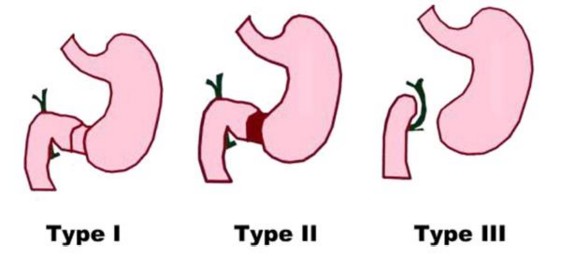Rare: constitutes about 1 % of all digestive atresias, or 1/100,000 live births.
A few familial cases with autosomal recessive inheritance have been reported
Clinical presentations:
- as an isolated anomaly
- in combination with epidermolysis bullosa (see this term): [MIM 601 282] due to a mutation of the PLEC gene on 8q24 that codes for plectine-1; if only localized cutaneous aplasia (aplasia cutis) is associated with pyloric atresia, this is called Bart syndrome; other mutations of the same gene may result in the association of pyloric atresia and muscular dystrophy (see limb-girdle dystrophies LGMDR17); mutations of the ITGB4 or ITGA6 gene can also cause an association of epidermolysis bullosa with pyloric atresia or Carmi syndrome (see this term) [MIM 226 730]
- in the context of multiple intestinal atresias, including esophageal atresia with or without fistula.
The prognosis is poor in the forms associated with epidermolysis bullosa or other digestive atresias.
There are 3 types of pyloric atresia:
- type I (60 %): presence of a membrane or one or two diaphragms in the pylorus
- type II: atresia without interruption of the digestive tract
- type III: atresia with a gap between the stomach and the duodenum.

Intestinal malrotation or absence of the gallbladder are sometimes associated.
Diagnosis:
- antenatal: polyhydramnios and dilated stomach: types II and III
- postnatal: high intestinal occlusion with non-bilious vomiting: type I, the detection of which can be delayed by several months
.jpg)
Anesthetic implications:
cardiac ultrasound; neonatal bowell occlusion; according to the anomalies associated with: epidermolysis bullosa, other atresias; in case of late diagnosis: importance of the preoperative chronic undernutrition
References:
- Okoye BO, Parikh DH, Buick RG, Lander AD.
Pyloric atresia: five new cases, a new association, and review of the literature with guidelines.
J Pediatr Surg 2000; 35: 1242-5.
- Dereure O.
Epidermolyse bulleuse simple associée à un atrésie pylorique liée à une mutation du gène de la plectine.
Ann Dermat Vénér 2006 ; 133 : 211-2.
- Andriessen MJG, Matthyssens LE, Heij HA.
Pyloric atresia.
J Pediatr Surg 2010; 45: 2470-2.
- Al-Salem AH, Abdulla MR, Kothari MR, Naga MI.
Congenital pyloric atresia, presentation, management, and outcome: a report of 20 cases.
J Pediatr Surg 2014; 49: 1078-82.
- Kansra M, Raman VS, Kishore K, Puri B, Sharna A.
Congenital pyloric atresia - nine new cases: single-center experience of the long-term follow-up and lessons learnt over a decade.
J Pediatr Surg 2018; 53: 2112-6.
- Alfayeza AA, Almutawab RA, Almesaiblic M, Albassamc A.
A baby diagnosed with epidermolysis bullosa associated with antral web.
J Pediatr Surgery Case Reports 2023 ; 93 : 102641, doi.org/10.1016/j.epsc.2023.102641
Updated: May 2024